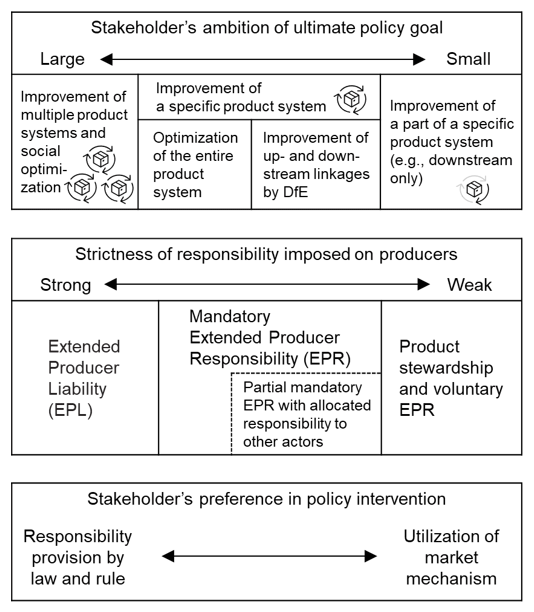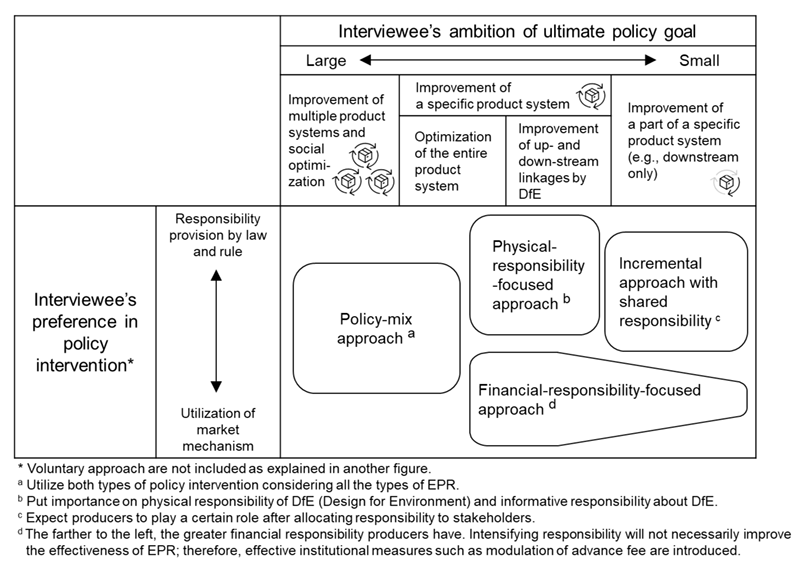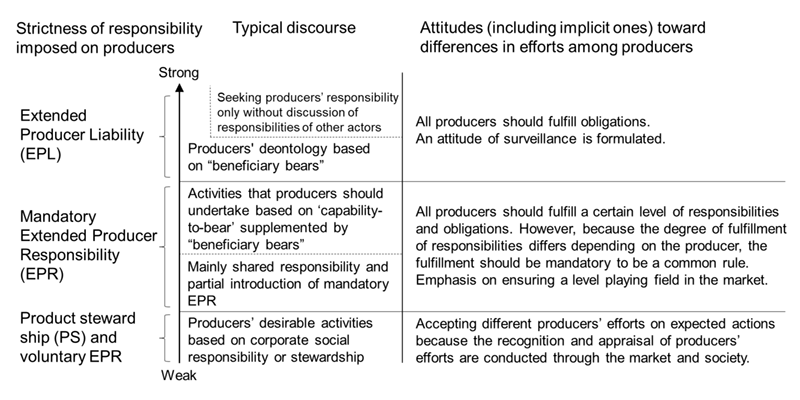[ Developing effective and efficient EPR schemes in keeping with global trends ]
Overview
- Policy theme
- Extended Producer Responsibility (EPR)
- Target audience
- Policy makers responsible for product policy and waste management, producers, distributors, recyclers, waste management companies, municipalities, non-profit civic organizations
- The problem
- Failure to optimize product systems due to evasion of EPR
- Policy options for resolving the problem
- Developing effective and efficient EPR schemes in keeping with global trends
*1 Head of Material Cycles and Social Systems Research Section, National Institute for Environmental Studies
*2 Representative, Eco-Intellect, LLC
Tasaki, T., Matsumoto, T. (2023) Developing effective and efficient EPR schemes in keeping with global trends. NIES-CMW Policy Brief #5 (https://www-cycle.nies.go.jp/eng/report/policy_brief_005.html)

Background
To effectively treat and recycle waste products, it is important to envision how they will be treated and recycled at the product design stage, and to ensure the involvement of producers in it. This concept, called Extended Producer Responsibility (EPR), emerged in the 1990s, and by around 2013, more than 350 EPR schemes were in existence worldwide (OECD 2016). The current number of EPR schemes in the world is unknown; however, in the United States alone, their number has increased by approximately 1.5 times in the last decade since 2013 (PSI 2023). The evolution of EPR schemes continues worldwide.
Japan has what might be called an ‘allergy’ to EPRs, thereby leading to the blaming of responsibility among stakeholders. EPR schemes in Japan remain in a partially optimized state due to failure to link to discussions to improve the entire product system of production, distribution, use, and disposal of products (Tasaki 2015). To date, there has been no active policy response to or adoption of the updated OECD EPR Guidance Manual (2016) or a modulated fee (OECD, 2021) that varies the fee based on product recyclability.
Global Trends in Design of EPR Schemes
What are the global trends in the design of EPR schemes while Japan is in a lock-in situation in the evolution of EPR schemes? The following are several points of view that the authors are focusing on, although in-depth research is needed.
Of these, an ‘umbrella’ legislation in (i) refers to an EPR scheme that covers a wide variety of products, and examples are the EPR schemes in France and Korea. The umbrella legislation easily focuses on the concept of EPR and applies it to multiple product categories under the same common concept; therefore, it tends to expand the number of product categories. France is adding 11 product categories from 2021 to 2025. The umbrella legislation is an interesting policy design from the dynamic perspective of ensuring the effectiveness of EPR schemes beyond a single product category, because it addresses and facilitates the handling of problems that fall between multiple schemes relatively easily. Regarding (ii), there is a policy trend to apply EPR, in addition to plastic containers and packaging, to other plastic products (toys, sporting goods, cigarette filters, fishing gear, etc.) in response to the global problem of plastic waste leakage into the ocean. In particular, EPR schemes for cigarette butts and fishing gear suggest that EPR schemes have been expanding their coverage to include product items to prevent littering, beyond the conventional purposes of EPR schemes for promotion of reuse and recycling and proper disposal of hazardous wastes (Deposit refund systems, regarded as one of EPR policies, have the same policy objective in terms of preventing littering, but the objective of deposit refund systems and the current trend are different. Deposit refund systems aim to collect specific useful discarded products for reuse and recycling and specific hazardous or difficult-to-dispose waste products for proper treatment, while the current trend of EPR policies is to add low-hazard but large amounts of waste products, such as plastic products, widely to the EPR schemes. The Packaging Recycling Act in Japan addresses low-hazard but large amounts of waste products; however, its main objectives are recycling and reducing waste, not preventing littering.) Regarding (iii), EPR schemes, in which expenditures are not only for the direct operational costs of collection, recycling, and treatment but also for public awareness, litter management, and technology development, have emerged. With regard to (iv), because existing fee systems under EPR schemes have not provided sufficient incentives to improve product design, such as recyclability, modulated fee systems aim to provide more incentives to producers by setting criteria for judging superior or inferior designs for the environment. Although the criteria are still being established on a trial-and-error basis, the basic concept of bonus malus is becoming a common guiding principle. It is a fee system in which fees for environmentally friendly product designs are reduced as a bonus (reward), and fees for inferior environmentally friendly product designs are increased as a malus (punishment).
Considering these global trends, stakeholders in Japan as well as other countries should discuss and further develop existing and new EPR schemes for more effective and efficient legislation on recycling and waste management.
Perception in Designing EPR Schemes: toward Effective Mechanism Design
It is important to revisit the concept of EPR, because the perception of EPR significantly influences the design of an EPR scheme. First, policy disputes over EPR tend to bog down on who should bear the responsibility for the products. More emphasis should be placed on fairness between stakeholders and the establishment of a level playing field, in which not only producers actively engage in EPR initiatives but also those who attempt to escape from the same actions are required to conduct minimum common rules in the market. The design of EPR schemes should also emphasize the creation of an institutional mechanism that enables stakeholders to implement actions easily.
Second, the authors (2022) pointed out in an academic paper that different approaches for introducing EPR schemes are advocated by different stakeholders based on their interviews with 12 Japanese stakeholders of EPR schemes, including producers (including producer responsibility organizations), consumers, municipal officials, and academics in the fields of law, economy, and policy science). Advocated policy approaches, such as the physical responsibility-oriented approach and policy-mix approach, depend on the interviewees’ level of policy ambition and preferences in policy intervention methods, as shown in Figure S1. In addition, based on their discussion of differences in the strictness of responsibility/liability imposed on producers, the authors explained the tendency for confusion between responsibility for mandatory EPR and liability for producer obligations as shown in Figure S2.
In summary, the design concept of EPR schemes differs greatly depending on the level of ambition of the goals to be achieved by the policy (top), strictness of the responsibility imposed on producers (middle), and preference in policy intervention methods (bottom) as shown in Figure 1. The design concept includes whether mandatory or voluntary schemes are pursued, whether importance is placed on the sharing of roles and responsibilities or on supervisory and oversight responsibilities, and whether importance is placed on the provision of duties or the use of market mechanisms.
In future policy discussions about EPR schemes, stakeholders should not adhere to these discussions, but discuss more about the effectiveness of institutional options, such as why a rule of bearing responsibility is more effective than other rules, why the use of market mechanisms is more effective than other policy options, and the dynamic effectiveness of institutional options in addressing emerging issues.

References
- OECD (2016) Extended Producer Responsibility, Updated Guidance for Efficient Waste Management, OECD Publishing, https://doi.org/10.1787/9789264256385-en
- OECD (2021) Modulated Fees for Extended Producer Responsibility Schemes (EPR), Environment Working Paper No. 184, OECD Publishing, https://doi.org/10.1787/2a42f54b-en
- Product Stewardship Institute, https://productstewardship.us/ (accessed on 12 May 2023)
- Tasaki T. (2015) Drawbacks Caused by Allocated Responsibilities in Recycling Legislation and Importance of Goal Setting. Review of Environmental Economics and Policy Studies, 8 (1), 78-81. https://doi.org/10.14927/reeps.8.1_78 (in Japanese)
- Tasaki T., Tojo N., Lindhqvist T. (2019) Differences in Perception of Extended Producer Responsibility and Product Stewardship among Stakeholders: An International Questionnaire Survey and Statistical Analysis. Journal of Industrial Ecology, 23 (2), 438-451. https://doi.org/10.1111/jiec.12815
- Tasaki T., Matsumoto T. (2022) Diverse Perceptions of Extended Producer Responsibility (EPR) and Implications for Policy Dialogue and Policy Development in Japan: Based on Stakeholder Interviews. Journal of the Japan Society of Material Cycles and Waste Management, 33, 178-192. https://doi.org/10.3985/jjsmcwm.33.178
Supporting information:


Beneficiary bears: EPR should be imposed because producers gain profits from manufacturing products, which become waste (causing waste).
Capability to bear: EPR should be imposed because producers’ capability is high within a product system. The numbers in the parentheses represent the number of provisions in the major category.


